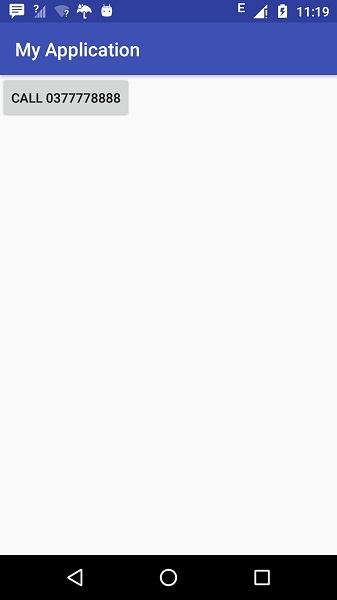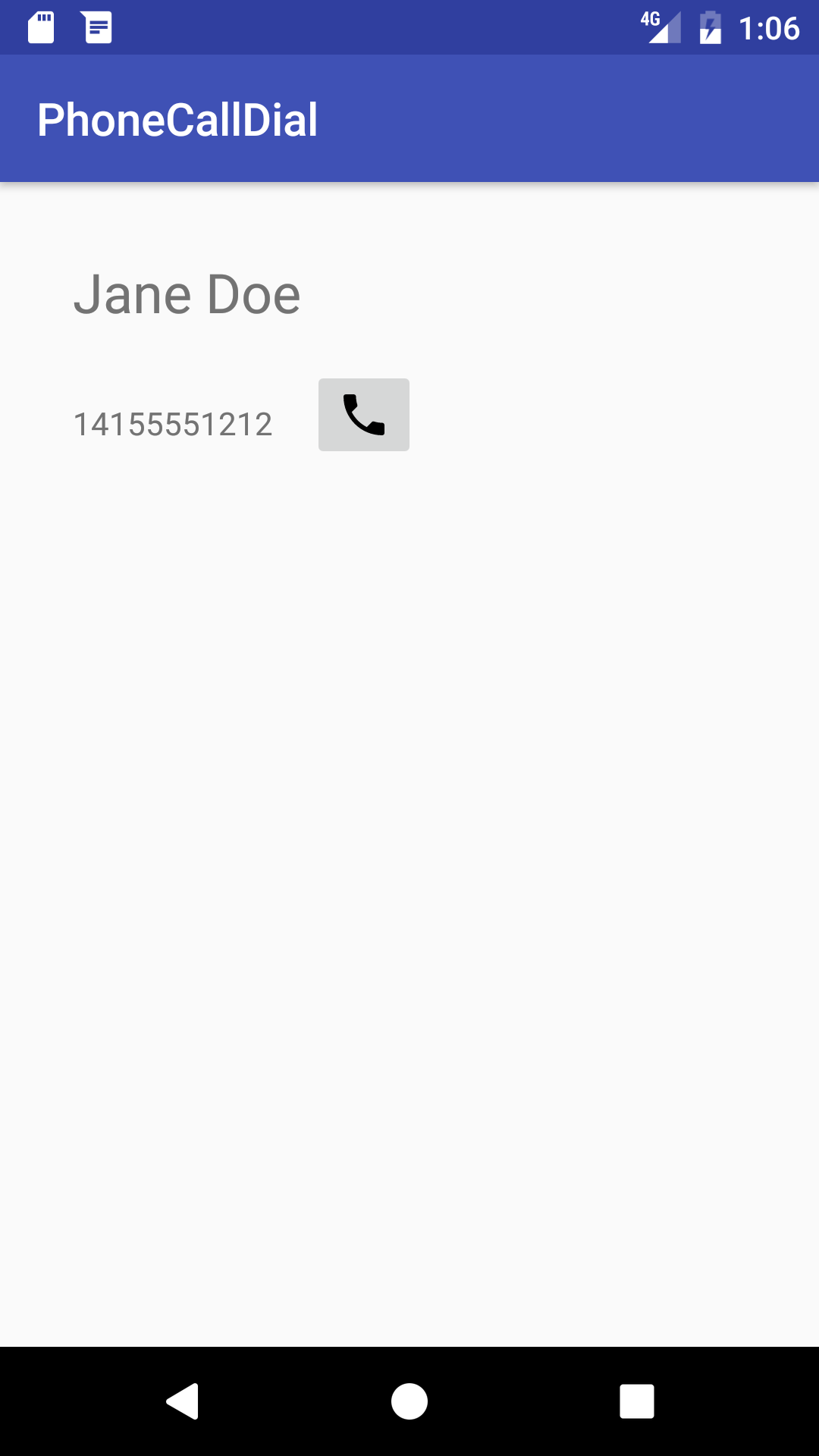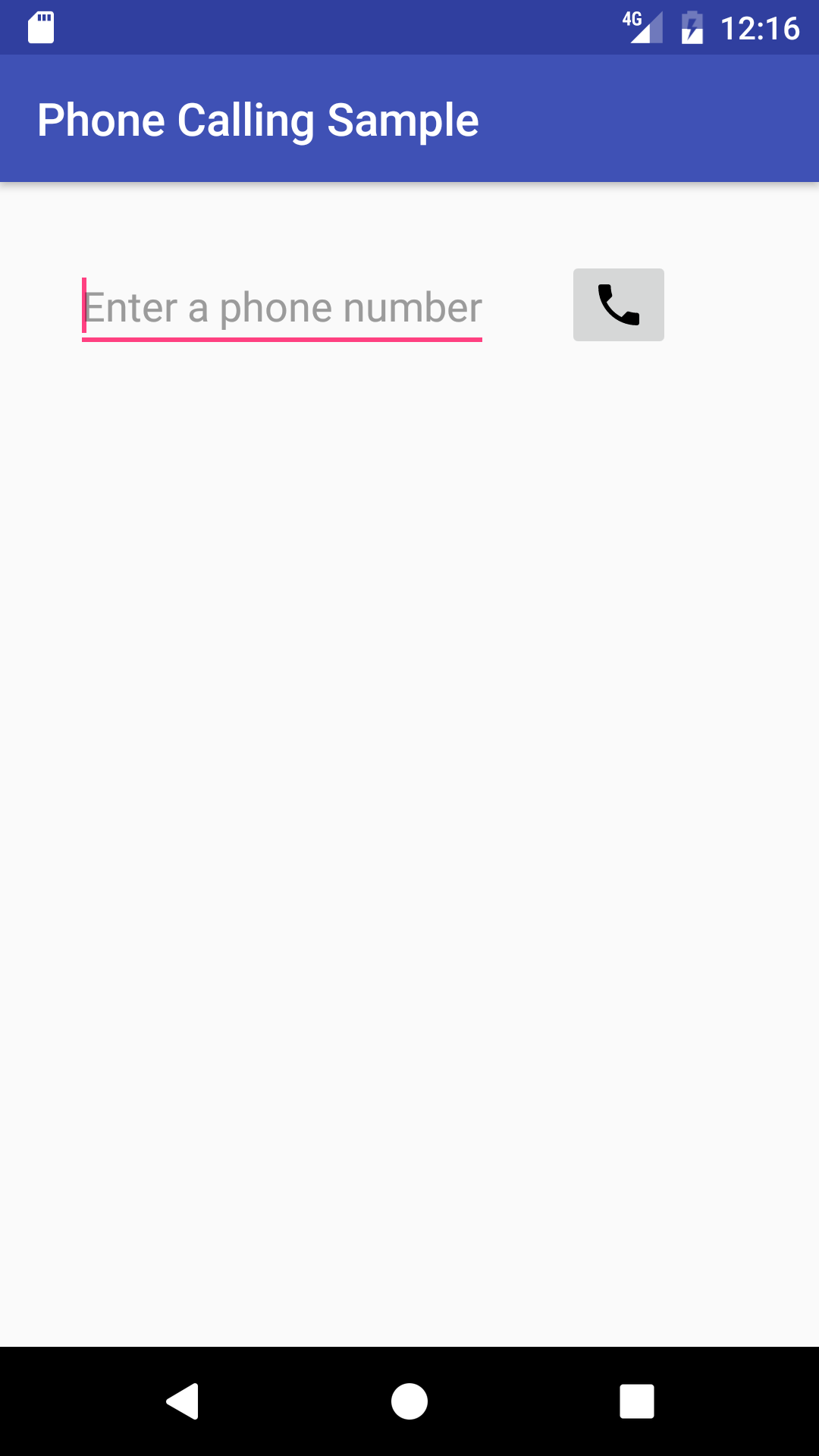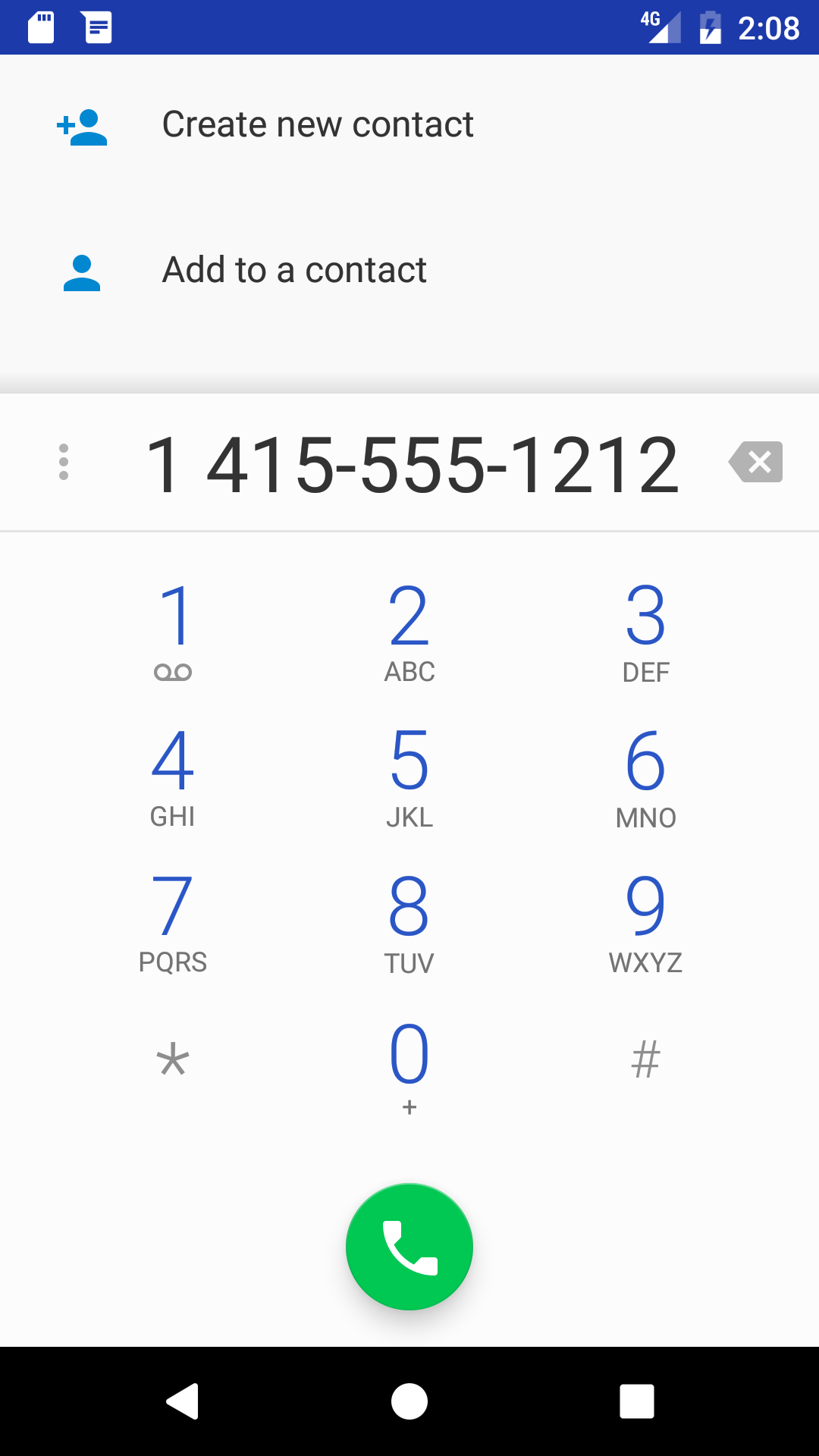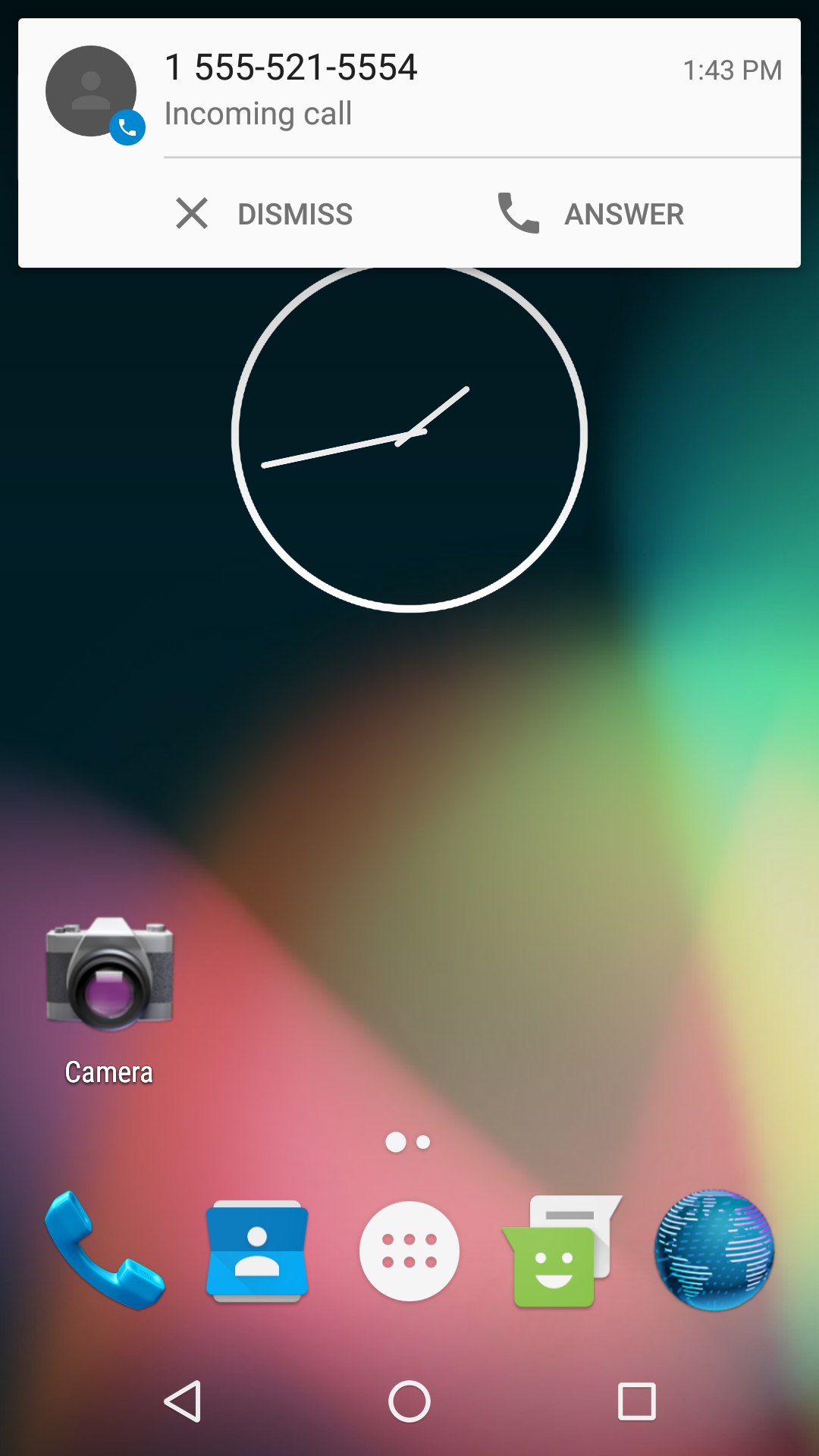- Android — Phone Calls
- Intent Object — Action to make Phone Call
- Intent Object — Data/Type to make Phone Call
- Example
- 1.1: Part 1 — Making Phone Calls
- What you should already KNOW
- What you will LEARN
- What you will DO
- App overview
- Task 1. Send an intent with the phone number to dial
- 1.1 Create the app and layout
- 1.2 Edit the onClick method in MainActivity
- 1.3 Run the app
- Solution code
- Task 2. Make a phone call from within an app
- 2.1 Create the app and add permission
- 2.2 Create the app layout
- 2.3 Change the onClick method in MainActivity
- 2.4 Run the app
Android — Phone Calls
Android provides Built-in applications for phone calls, in some occasions we may need to make a phone call through our application. This could easily be done by using implicit Intent with appropriate actions. Also, we can use PhoneStateListener and TelephonyManager classes, in order to monitor the changes in some telephony states on the device.
This chapter lists down all the simple steps to create an application which can be used to make a Phone Call. You can use Android Intent to make phone call by calling built-in Phone Call functionality of the Android. Following section explains different parts of our Intent object required to make a call.
Intent Object — Action to make Phone Call
You will use ACTION_CALL action to trigger built-in phone call functionality available in Android device. Following is simple syntax to create an intent with ACTION_CALL action
You can use ACTION_DIAL action instead of ACTION_CALL, in that case you will have option to modify hardcoded phone number before making a call instead of making a direct call.
Intent Object — Data/Type to make Phone Call
To make a phone call at a given number 91-000-000-0000, you need to specify tel: as URI using setData() method as follows −
The interesting point is that, to make a phone call, you do not need to specify any extra data or data type.
Example
Following example shows you in practical how to use Android Intent to make phone call to the given mobile number.
To experiment with this example, you will need actual Mobile device equipped with latest Android OS, otherwise you will have to struggle with emulator which may not work.
| Step | Description |
|---|---|
| 1 | You will use Android studio IDE to create an Android application and name it as My Application under a package com.example.saira_000.myapplication. |
| 2 | Modify src/MainActivity.java file and add required code to take care of making a call. |
| 3 | Modify layout XML file res/layout/activity_main.xml add any GUI component if required. I’m adding a simple button to Call 91-000-000-0000 number |
| 4 | No need to define default string constants.Android studio takes care of default constants. |
| 5 | Modify AndroidManifest.xml as shown below |
| 6 | Run the application to launch Android emulator and verify the result of the changes done in the application. |
Following is the content of the modified main activity file src/MainActivity.java.
Following will be the content of res/layout/activity_main.xml file −
Following will be the content of res/values/strings.xml to define two new constants −
Following is the default content of AndroidManifest.xml −
Let’s try to run your My Application application. I assume you have connected your actual Android Mobile device with your computer. To run the app from Android studio, open one of your project’s activity files and click Run 
Now use Call button to make phone call as shown below −
Источник
1.1: Part 1 — Making Phone Calls
Contents:
Android mobile devices with telephone/cellular service are pre-installed with a Phone app for making calls, which includes a dialer for dialing any phone number. You use an implicit Intent to launch the Phone app from your app. You have two choices:
- Use ACTION_DIAL to launch the Phone app independently from your app with the phone number displayed in the dialer. The user then makes the call in the Phone app. This is the preferred action for apps that don’t have to monitor the phone’s state.
- Use ACTION_CALL to launch the Phone app in the context of your app, making the call directly from your app, and monitoring the phone state. This action keeps the user within your app, without having to navigate back to the app. Your app must request permission from the user before making the call if the user hasn’t already granted permission.
What you should already KNOW
From the previous chapters, you should be able to:
- Create and run interactive apps in Android Studio.
- Work with XML layouts.
- Create an implicit intent to perform an action using another app.
What you will LEARN
In this practical, you will learn to:
- Pass a phone number to the Phone app’s dialer.
- Perform a phone call within your app.
- Test to see if telephony services are enabled.
- Check for calling permission, and request permission if required.
What you will DO
In this practical, you will:
- Create an app that uses an implicit intent to launch the Phone app.
- Create another app that makes phone calls from within the app.
- Test to see if telephony services are enabled before enabling the app.
- Check for calling permission, which can change at any time.
- Request permission from the user, if necessary, to make the call.
App overview
You will create two apps:
PhoneCallDial: A basic app that uses an implicit intent to launch the Phone app with a hard-coded phone number for dialing. The Phone app makes the call. You could use this technique to provide a one-button dialer to custom support. In this lesson you will build a layout, shown in the figure below. It includes a TextView with a hard-coded phone number, and an ImageButton with an icon to launch the Phone app with that phone number in its dialer.
Phone Calling Sample: An app that secures permission, uses an implicit intent to make a phone call from the app, and uses the TelephonyManager class to monitor the phone’s state. You would use this technique if you want to keep the user within your app, without having to navigate back to the app. In this lesson, you modify the above layout to use an EditText so that users can enter the phone number. The layout looks like the figure below:
Task 1. Send an intent with the phone number to dial
In this task you will create an app that uses an implicit intent to launch the Phone app to dial a given phone number. To send that intent, your app needs to prepare a Uniform Resource Identifier (URI) that is prefixed by «tel:» (for example tel:14155551212 ).
1.1 Create the app and layout
Create a project using the Empty Activity template and call it PhoneCallDial.
Add an icon for the call button by following these steps:
Select the drawable/ folder in the Project: Android view and choose File > New > Vector Asset.
Click the Android icon next to «Icon:» to choose an icon. To find a handset icon, choose Communication in the left column.
Select the icon, click OK, click Next, and then click Finish.
Open the activity_main.xml layout file.
- Change the root view to RelativeLayout.
- In the «Hello World» TextView element, remove the layout_constraint attributes, if they are present.
- Change the TextView to show a dummy contact name, as if the app had retrieved the name from a contacts database and assigned it to a TextView:
Extract the strings and dimensions into resources:
- 24sp : contact_text_size for the text size.
- Jane Doe : contact_name for the text.
Add another TextView for the phone number:
You will use the android:id number_to_call to retrieve the phone number.
After adding a hard-coded phone number string, extract it into the resource phone_number .
Add an ImageButton for initiating the call:
Use the vector asset you added previously (for example ic_call_black_24dp for a phone handset icon) for the android:src attribute. You will use the android:id @phone_icon to refer to the button for dialing the phone.
The dialNumber method referred to in the android:onClick attribute remains highlighted until you create this method in the MainActivity, which you do in the next step.
After adding a hard-coded content description, extract it into the string resource make_a_call .
Click dialNumber in the android:onClick attribute, click the red light bulb that appears, and then select Create dialNumber(View) in ‘MainActivity’. Android Studio automatically creates the dialNumber() method in MainActivity as public , returning void , with a View parameter. This method is called when the user taps the ImageButton.
The layout should look something like the figure below.
The following is the complete code for the XML layout in activity_main.xml, including comments:
1.2 Edit the onClick method in MainActivity
- In MainActivity, define a constant for the log tag.
- Inside the dialNumber() method created in the previous section, create a reference to the number_to_call TextView:
- To create the phone number URI string phoneNumber , get the phone number from textView and use it with String.format to include the tel: prefix:
- Define an implicit intent ( dialIntent ) with the intent action ACTION_DIAL , and set the phoneNumber as data for the intent:
- To verify that an app exists to receive the intent, call resolveActivity() on your Intent object with getPackageManager() to get a PackageManager instance for finding package information. The resolveActivity() method determines the best action to perform for a given intent. If the result is non-null, there is at least one app that can handle the intent and it’s safe to call startActivity() .
The full method should now look like the following:
1.3 Run the app
You can run the app on either an emulator or a device:
Click or tap the phone icon. The dialer should appear with the phone number ready to use, as shown in the figure below:
The phone_number string holds a fixed number (1-415-555-1212). You can change the number in the Phone app’s dialer before calling.
Use the Back button to return to the app. You may need to tap or click it two or three times to navigate backwards from the Phone app’s dialer and Favorites list.
Solution code
Android Studio project: PhoneCallDial
Task 2. Make a phone call from within an app
In this task you will copy the PhoneCallDial app from the previous task, refactor and rename it to PhoneCallingSample, and modify its layout and code to create an app that enables a user to enter a phone number and perform the phone call from within your app.
In the first step you will add the code to make the call, but the app will work only if telephony is enabled, and if the app’s permission for Phone is set manually in Settings on the device or emulator.
In subsequent steps you will do away with setting this permission manually by requesting phone permission from the user if it is not already granted. You will also add a telephony check to display a message if telephony is not enabled and code to monitor the phone state.
2.1 Create the app and add permission
- Copy the PhoneCallDial project folder, rename the folder to PhoneCallingSample, and refactor the app to populate the new name throughout the app project. (See the Appendix for instructions on copying a project.)
Add the following permission to the AndroidManifest.xml file after the first line (with the package definition) and before the section:
Your app can’t make a phone call without the CALL_PHONE permission line in AndroidManifest.xml. This permission line enables a setting for the app in the Settings app that gives the user the choice of allowing or disallowing use of the phone. (In the next task you will add a way for the user to grant that permission from within the app.)
2.2 Create the app layout
- Open activity_main.xml to edit the layout.
- Remove the contact_name TextView, and replace the number_to_call TextView with the following EditText view:
After adding a hard-coded string for the android:hint attribute, extract it into the string resource enter_phone , and note the following:
- You will use the android:id for the EditText view in your code to retrieve the phone number.
- The EditText view uses the android:inputType attribute set to «phone» for a phone-style numeric keypad.
Change the ImageButton as follows:
Change the android:layout_below , android:layout_toRightOf , and android:layout_toEndOf attributes to refer to editText_main .
Add the android:visibility attribute set to visible . You will control the visibility of this ImageButton from your code.
Change the android:onClick method to callNumber . This will remain highlighted until you add that method to MainActivity.
- You will refer to the the android:id button_retry in your code.
- Make sure you include the android:visibility attribute set to «invisible» . It should appear only if the app detects that telephony is not enabled, or if the user previously denied phone permission when the app requested it.
Your app’s layout should look like the following figure (the button_retry Button is invisible):
2.3 Change the onClick method in MainActivity
- In MainActivity, refactor and rename the dialNumber() method to call it callNumber() .
- Change the first statement, which referred to a TextView, to use an EditText view:
- Change the next statement to get the phone number from the EditText view ( editText ) to create the phone number URI string phoneNumber :
- Before the intent, add code to show a log message and a toast message with the phone number:
- Extract «Phone Status: DIALING: » to a string resource ( dial_number ). Replace the second use of the string in the Toast.makeText() statement to getString(R.string.dial_number) .
- Refactor and rename the dialIntent implicit intent to callIntent , and replace ACTION_DIAL with ACTION_CALL . As a result, the statements should now look like this:
The full method should now look like the following:
2.4 Run the app
When you run the app, the app may crash with the following screen depending on whether the device or emulator has been previously set to allow the app to make phone calls:
In some versions of Android, this permission is turned on by default. In others, this permission is turned off by default.
To set the app’s permission on a device or emulator instance, perform the function that a user would perform: choose Settings > Apps > Phone Calling Sample > Permissions on the device or emulator, and turn on the Phone permission for the app. Since the user can turn on or off Phone permission at any time, you have to add a check in your app for this permission, and request it from the user if required. You will do this in the next task.
If you don’t have cellular service on your device, or if telephony is not enabled, you can test the app using two emulator instances—one emulator instance calls the other one. Follow these steps:
- To launch an emulator directly from the AVD Manager, choose Tools > Android > AVD Manager.
Double-click a predefined device. Note the number that appears in the emulator’s window title on the far right, as shown in the figure below as #1 (5556). This is the port number of the emulator instance.
Open the Android Studio project for the app, if it isn’t already open.
Run the app, but choose another emulator—not the one that is already running. Android Studio launches the other emulator.
In the app, enter the port number of the other emulator rather than a real phone number.
Click the call button in the app. The emulator shows the phone call starting up, as shown in the figure below. 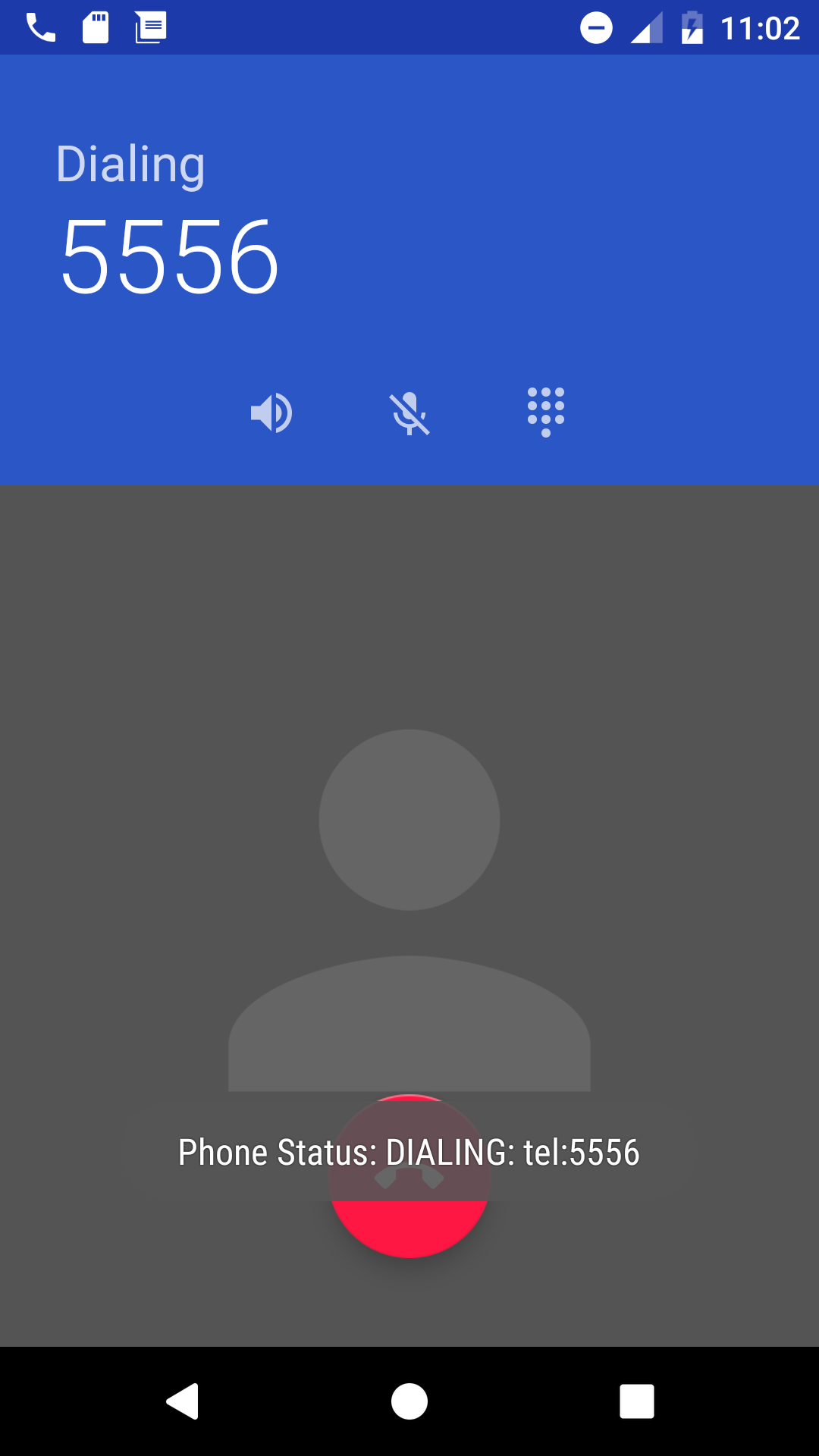
Click Answer or Dismiss on the emulator receiving the call. If you click Answer, also click the red Hang-up button to end the call.
Источник
